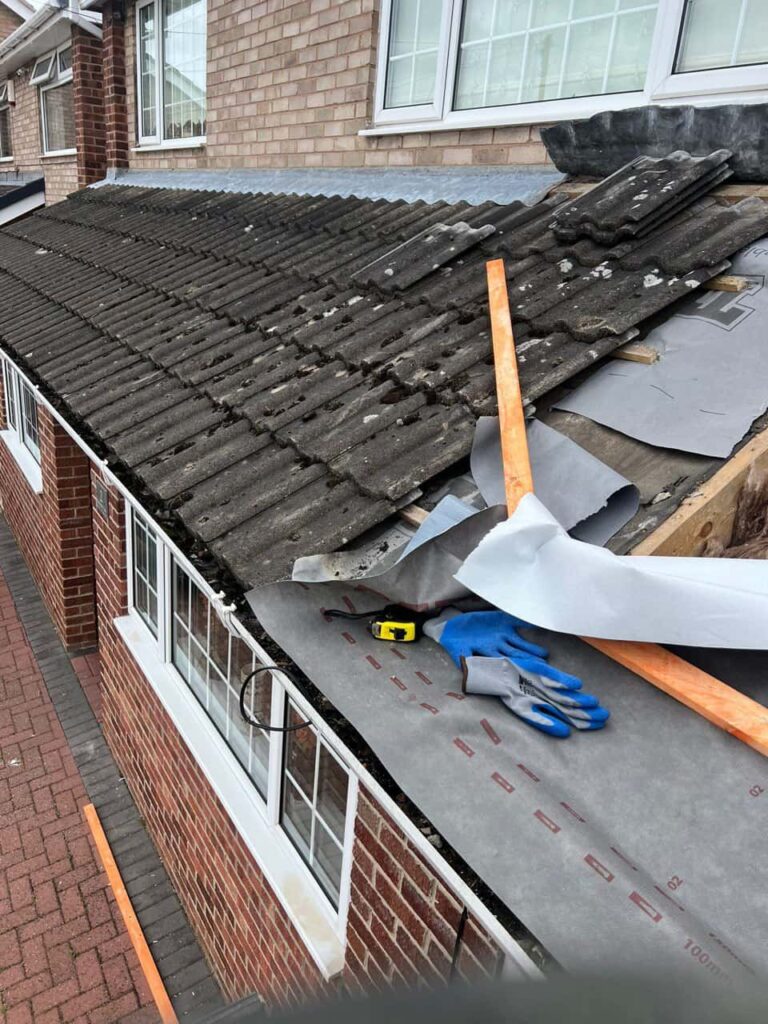Felt roofing has been a trusted roofing material for decades, known for its reliability, affordability, and effectiveness in protecting properties from the unpredictable British weather. Despite the rise of modern alternatives such as rubber and fibreglass systems, felt remains a popular choice for flat roofs, garages, extensions, and outbuildings. At Smethwick Roofing Repairs, we continue to see strong demand for felt roofing across Smethwick, West Midlands, thanks to its proven track record and long-lasting performance when installed correctly.
What Is Felt Roofing?
Felt roofing is made up of multiple layers of bitumen-saturated material, reinforced with fibreglass or polyester, and sealed with heat or adhesive to create a waterproof membrane. This composition allows it to provide a durable, watertight barrier that protects the underlying structure from rain, frost, and wind damage.
Traditionally, felt was laid using hot bitumen and a blowtorch, but modern versions have evolved significantly. Today’s high-performance felt systems are more flexible, UV-resistant, and easier to maintain, making them suitable for both domestic and commercial applications.
Why Felt Roofing Remains a Reliable Choice
Even with technological advancements in the roofing industry, felt continues to be used because of its many practical advantages. Smethwick Roofing Repairs regularly recommends felt roofing for flat roof installations and repairs where long-term protection and easy maintenance are key.
Some of the main reasons for its continued popularity include:
- Proven performance – Felt has a long history of reliability, particularly in the UK’s damp climate.
- Excellent waterproofing – The layered system ensures complete protection against leaks and moisture penetration.
- Adaptability – Suitable for various structures, including sheds, extensions, garages, and flat roofed homes.
- Ease of repair – Damaged sections can often be repaired without replacing the entire roof.
- Modern enhancements – Reinforced felts with added UV protection and superior adhesives offer improved lifespan and durability.
How Felt Roofing Is Installed
A successful felt roof installation requires professional handling to ensure complete waterproofing and longevity. The process usually involves:
- Preparing the roof surface – Removing old material and ensuring the decking is smooth, dry, and secure.
- Applying the underlay – The first layer provides stability and acts as a base for further layers.
- Installing the top layers – These are sealed using heat or cold adhesives to form a continuous watertight finish.
- Edge detailing and sealing – Ensuring all edges, corners, and joints are properly sealed to prevent water ingress.
At Smethwick Roofing Repairs, we use only high-quality materials and professional techniques to deliver dependable results for every felt roofing project in Smethwick, West Midlands.
Where Felt Roofing Works Best
Felt roofing is particularly well-suited for flat or low-sloped roofs, where traditional tiles or slates would be impractical. It’s commonly applied on:
- Home extensions and porches
- Garages and workshops
- Outbuildings and garden offices
- Sheds and smaller storage structures
- Certain commercial and industrial flat roofs
Because of its adaptability, felt remains one of the most versatile materials available for both residential and light commercial projects.
Maintaining a Felt Roof
Like any roofing system, felt roofs benefit from routine maintenance to maximise their lifespan. Key upkeep tasks include:
- Regular inspections to spot signs of wear, cracks, or blisters
- Clearing debris from gutters and outlets to prevent pooling water
- Addressing minor damage promptly to avoid larger repairs later
- Ensuring flashings and seals remain secure
Smethwick Roofing Repairs provides comprehensive felt roof maintenance services across Smethwick, ensuring every property remains fully protected year-round.
The Modern Relevance of Felt Roofing
While materials such as EPDM and GRP have become popular alternatives, felt continues to hold its place in modern construction due to its balance of cost-effectiveness, reliability, and practicality. Advances in technology mean modern felts are more durable and resistant to UV damage, reducing shrinkage and cracking over time.
For many homeowners and property managers, felt roofing remains a trusted and proven solution that provides excellent protection when installed and maintained by professionals.
Conclusion
Felt roofing may be one of the oldest roofing systems still in use today, but its durability, practicality, and adaptability make it just as relevant in modern construction as ever. When installed and maintained properly, it offers years of dependable protection against the British weather.
Smethwick Roofing Repairs continues to provide expert felt roofing installations, repairs, and maintenance throughout Smethwick, West Midlands. Whether you’re replacing an old flat roof or maintaining an existing one, our experienced team can ensure your property remains watertight, secure, and built to last.
Call us on: 0121 270 9 085
Click here to find out more about Smethwick Roofing Repairs
Click here to complete our contact form and see how we can help with your roofing needs.

